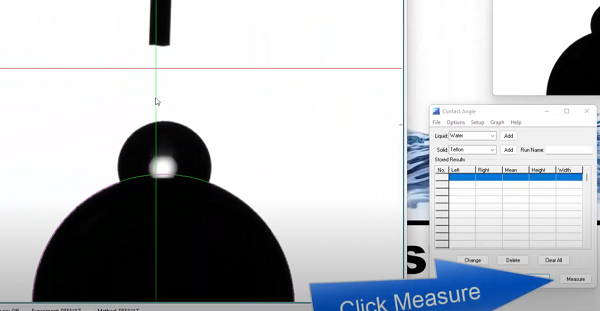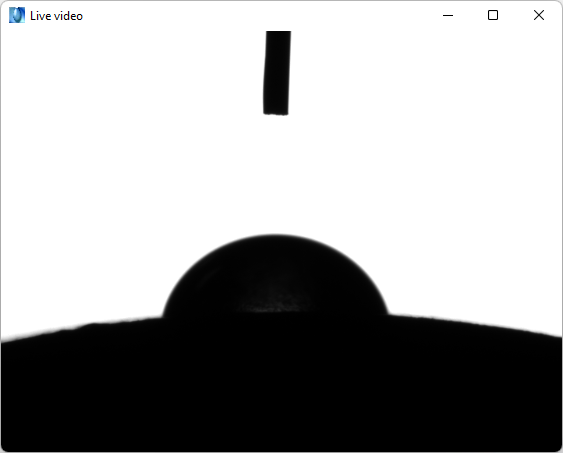|
March 2023 |
| Curved Baseline in DROPimage Advanced |
|
An ideal surface is an atomically flat, chemically homogeneous, isotropic, insoluble, nonreactive and nondeformed solid surface.1 Of course in the real world, there are not very many ideal surfaces, if any. As a result, we constantly deal with what are referred to as "real surfaces" - in other words, surfaces that somehow fall short of the "ideal". Flatness comes in handy when measuring wetting properties via contact angle. And, fortunately, most real surfaces are flat or flat enough or can easily be made flat. But alas, there are exceptions - contact lenses, ball bearings, tubing, to name a few. In the past, we developed a number of tricks for taking accurate contact angle measurements on curved or convex surfaces. However, they are a bit tedious requiring you to adjust the tilt of the specimen stage in order to align the baseline at the three-phase line so that it's tangent to the horizontal baseline. This requires taking the left and right contact angles separately. In short, it's less than ideal for measuring contact angle on surfaces that are, well, less than ideal. For this reason and in an effort to make our flagship DROPimage Advanced software even more powerful and easy to use on all types of real surfaces, we added a curved baseline option which will work on curved or convex surfaces of almost any size.
The curved baseline feature that has been added to version 3.23.2 of DROPimage Advanced is now shipping with any new instrument that includes DROPimage Advanced. It's easy to use. We created a video which can be seen here that shows step-by-step how to enable and use the curved baseline using the Contact Angle Tool. In the video, we change the baseline to "curved", turn on the red line option and dispense a water drop on top of a 4mm ball. We then show how easy it is to align the curved baseline with the profile of the surface. We then accurately measure both the left and right contact angles simultaneously. Next, we measure the water contact angle on a much larger sample with a larger curvature radius using a smaller drop. Dynamic contact angle measurements are also possible by increasing beyond 1 the number of measurements at a fixed time interval.
If you have an application that could benefit from a curved baseline option and you already have an instrument with DROPimage Advanced, contact us and be sure to include your instrument serial number and we can let you know if a free upgrade is available. A small charge may be necessary for older instruments. And if you are running DROPimage Pro or DROPimage Standard, an upgrade to DROPimage Advanced is also available. Contact us for a quotation and include your current instrument serial number if you are upgrading. Finally, if you're looking into a new instrument with DROPimage Advanced, check out our various models here. And when you're ready, contact us for a no-obligation quotation. Notes |
| Technical Considerations for Measuring Contact Angle on Convex Surfaces |
|
A significant amount of research has
been done on wetting behavior on spheres and convex surfaces.
Extrand and Moon discovered that as the drop volume of a sessile
drop on a sphere or convex surface increases, the three-phase line
advances both outward and downward. As the slope at the contact line
increases, the apparent advancing contact angle progresses. However,
in order to correctly interpret the apparent contact angle, it's
necessary to take into account both the curvature and drop geometry.1
If you read their paper, you will find their math for doing so. Researchers in China developed a method for determining the apparent contact angle of a drop on a convex surface by using the drop volume.2 While their model may be useful for people who don't have DROPimage Advanced, our new release makes this model less useful. Nonetheless, the influence of the radius of the curved surface is critical to understanding wetting behavior on both convex and concave surfaces. At NC State, researchers detailed theoretical principles of curved surfaces taking into account both the surface topology as well as the curvature value.3 Their model was used to predict the sign and magnitude of line tension for a variety of alkanes. In fact, they further predicted two equilibrium contact angle for small drops in certain circumstances.
Researchers in India demonstrated both experimentally and theoretically the behavior of the three-phase line for a sessile drop on both cylindrical as well as spherical superhydrophobic surface.4 A key observation was that as the radius of curvature of the convex surface increases, the velocity of advection within the drop decreases. Lastly, Manfredo Guilizzoni, an Italian researcher, proposed a model using image processing, spline fitting, and numerical analysis to determine wetting behavior on curved and spherical surfaces.5 The method does not require the drop volume or surface tension of the liquid but relies on visualization to determine the equilibrium contact angle on curved surfaces. The technique proves to be particularly useful for determining wetting behavior of gemstones and other three-dimensional sculptured surfaces. Moving from a flat surface to one that is cylindrical or concave can introduce a number of considerations that merit further study. While some work has been done in this area, there appears to be a number of unanswered questions that merit further investigation. Notes |
|
Regards,
Carl Clegg |



